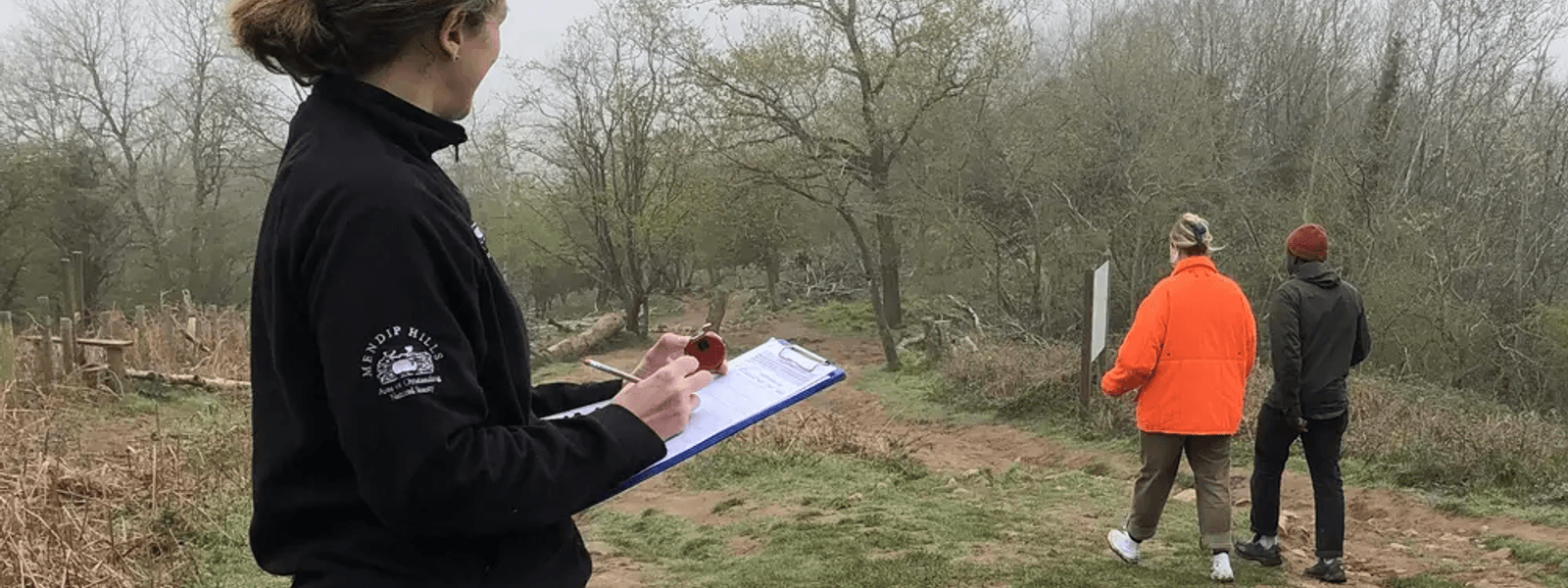Overview
The Counting on Mendip project investigates when, where and how people explore the Mendip Hills Area of Outstanding Natural Beauty (AONB).
The project commenced in 2021 and consists of two components, both of which record visitor behaviour:
1) A network of visitor counters, and,
2) An annual visitor survey, “The Big Visitor Count”.
Initial work involved designing the method for collecting visitor data, liaising with landowners and installing visitor counter equipment. Volunteer Rangers completed specialist training and conduct the visitor counter data downloading and maintenance, as well as, conducting The Big Visitor Count.
To date, the data collected has improved our understanding of when, where, and how people visit the Mendip Hills AONB, informing management of sites, directing resource and helping landowners and managers understand visitor behaviour.
Project aims
The initial project set-up was funded by National Grid’s Community Grant Programme and it has been running continuously since 2021.
The aims and objectives of Counting on Mendip are:
1. To develop, implement and coordinate a reliable and sustainable programme for collecting and analysing data on visitor numbers and behaviour at key locations across the AONB.
2. To establish and support a network of volunteers from the community and key landowners to support data collection and long-term sustainability of the project.
3. To use the project as a tool to inform the public on the importance of sustainable recreation.
4. To use the data gathered to better inform management and promotion of sustainable recreation in the AONB.
What was done
The project consists of two components, both of which record visitor behaviour:
1) A network of visitor counters and,
2) An annual visitor survey, “The Big Visitor Count”.
Visitor counters
We have visitor counters at 15 sites across the AONB recording the number of visits to these sites.
Identifying these sites was key to the success of the project; sites needed to be suitable for data collection (within the limitations of the equipment), supported by landowners and managers, and representative of visitor behaviour at that site (i.e., visitor counters were not located on the quietest section of a busy site).
The Big Visitor Count
The Big Visitor Count is conducted at the same time, on the same day and at the same locations every year.
We record the number and type of visitor at each site (on foot, dog walker, cyclist, horse rider, other). Volunteer Rangers are key to the success of the project, not only in assisting with data collection but acting as our “eyes on the ground”; checking equipment, explaining the project to visitors, and promoting sustainable recreation across the Mendip Hills. They undertook specialist training to deliver this activity.
The project produces a wealth of data which is collated and circulated to a variety of landowners and managers, helping them to understand visitor behaviour on their sites. We also use it at the AONB to inform management of resources and best practice.
Outcomes
How many people visit the Mendip Hills AONB? We don’t know.
We do know how many people visit different sites; we know when they’re busiest and when they’re quietest.
We understand how people use different sites differently and we are able to direct resource and management accordingly. We understand what “busy” means at different sites.
In the long-term, we can look at change over time. In effect, we have an early warning system which will detect increase in visitors and enable us to respond accordingly. We will be able to understand the impact external factors such as housing developments have on certain sites, as well as internal factors such as site management and car parking.
The Counting on Mendip Project has involved engaging and working with a variety of landowners and land managers. This has included: Bristol Water, Forestry England, Natural England, National Trust, Somerset Wildlife Trust, Longleat, Somerset County Council, Parish Councils, as well as local farmers and Local Authority Rights of Way teams.
“It’s great to be involved in something so worthwhile, I can see the impact of the work and the value to the Mendip Hills”.
Volunteer Ranger
Learnings
There are a many methods for measuring the number of visitors to an area. From manual surveys, standard visitor counters (that we have used), to more high-tech visitor counters (which connect to a mobile phone network to send data and have solar panels for energy).
Researchers, and now private companies, can use mobile phone data to study visitor numbers to sites, as well as tracking their route on site.
A number of factors influenced the methods we used in the Counting on Mendip project; cost was a factor, as was time and analysis of data. We were also concerned about vandalism to counters so chose the most discreet equipment that we could find.
Identifying the locations for the visitor counter equipment was key to the success of the project both in accurately and reliably collecting meaningful data and in working with landowners and managers who were motivated to accommodate the equipment.
Whilst it is not possible to capture all the visitors to a site using visitor counters, we chose locations which were representative of the whole site to try to ensure that changes in visitor numbers at the visitor locations reflected changes across the whole site.
Identifying the locations for the visitor counter equipment was key to the success of the project both in accurately and reliably collecting meaningful data and in working with landowners and managers who were motivated to accommodate the equipment and therefore care for the equipment on an ongoing basis.
A long-term commitment of time and resource is essential for the project - there’s no point collected lots of data if no one analyses it!
“You managed to make something that could have been boring really interesting! It was fascinating to see how the visitor counter data is being used by the AONB Team but it is also useful for my business."
Local business owner.
